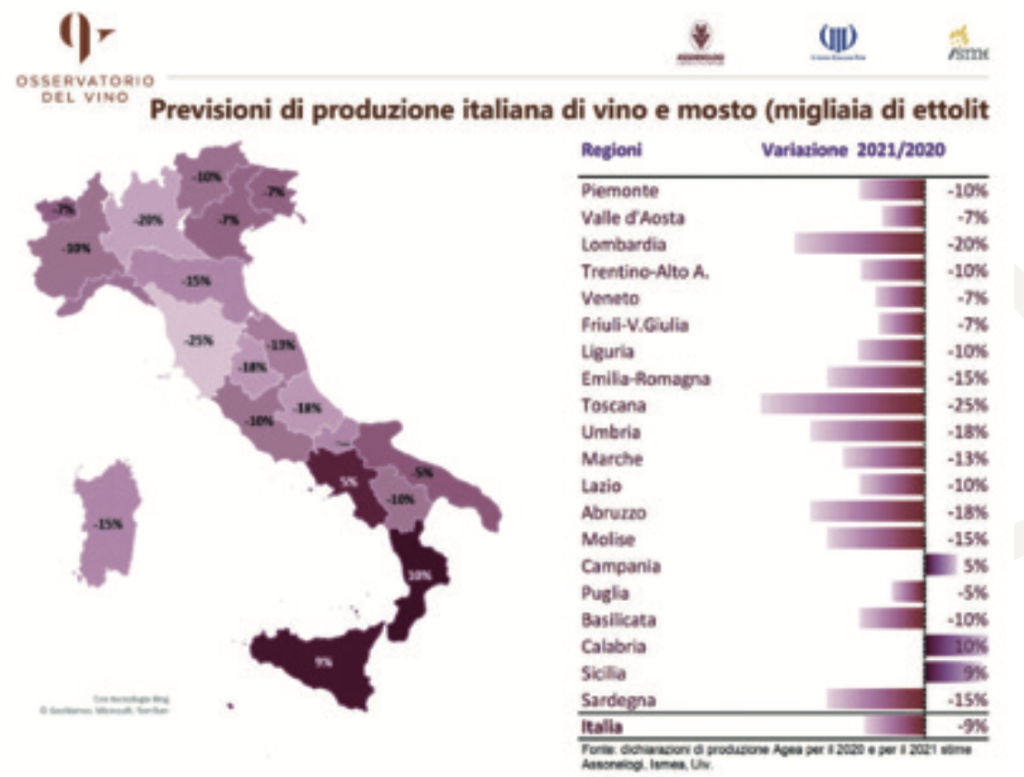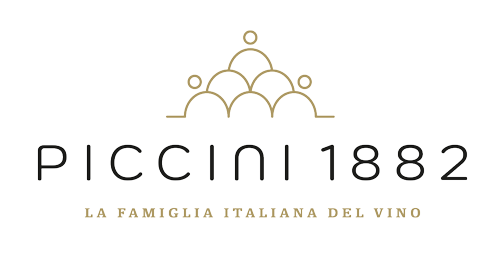2021 OPENED ITS DOORS PROPITIATED BY A RAIN-FILLED WINTER SUPPORTED BY TEMPERATURES IN LINE WITH PREVIOUS YEARS. WINTER’S RIGORS, HOWEVER, LINGERED UNTIL THE THRESHOLD OF SPRING, KEEPING THE THERMOMETER BELOW THE NATIONAL AVERAGE.
The vagaries of the weather, however, did not hinder the phenological development of the vine, which throughout the Boot took a regular course. Unfortunately, April’s bitter temperatures put an abrupt halt to nature’s awakening, storming many north-central hillsides with sudden frosts. In these regions, the inclemency of the weather dragged the thermometer bar below 4 degrees Celsius, causing, in some cases, the halting of new sprouting.
Summer has responded to the rigors of spring by red-hotening the Bel Paese with an unprecedented heat wave. Crushed in the grip of the heatwave, vines responded to water stress with lower yields than in previous years. The last few months have allowed nature’s cycles to fall back into place, providing a good temperature range between day and night and giving some relief to the plants’ water balance with satisfactory moisture content. Although tested by the torments of the weather, the grapes therefore faced the final sprint of ripening with the favor of a more generous September, offering fruit of excellent quality from a vegetative and phytosanitary point of view.
Unfortunately, the sudden ups and downs of weather conditions have irreparably compromised the quantity of grapes produced. The impact of frost and water shortages have battered many regions in central Italy, such as Tuscany, where production has fallen dramatically by 25 percent. The home of Chianti suffered the greatest losses, closely followed by neighboring regions. Instead, Sicily is smiling, where estimates show a reassuring 9 percent increase over last year’s production.

“The 2021 harvest has not been particularly generous in Tuscany,” notes Marco Cerqua, winemaker at Piccini’s winery, “the small quantities of grapes harvested have proved the estimates right. However, the drop in quantity was not followed by a drop in quality. The blanket of frosts and summer drought slowed ripening, while the July-August heat, while stinging with high heat spikes, did not affect plant health. The harvested grapes look healthy and juicy, capable of giving excellent fruit concentration. In particular, the Vermentini and Vernacce show off delicious acidity and an amazing organoleptic balance.”
In the hills of Chianti Classico, where Fattoria di Valiano is located, winemaker Pasquale Presutto takes stock of the situation: “Fortunately, here the vintage has gone off without any major twists and turns. The higher altitudes, which the Chianti Classico area enjoys, have nullified the impact of the frosts, which elsewhere took their bite. However, the scorching sun of July and August did not spare the vines from drought, also fueled by winds that further dried out the soil. The final quantity of grapes will not come, but their quality makes us hopeful. All these premises portend a warm and persuasive vintage that will win the hearts of wine lovers. The 2021-brand Chianti Classico wines will offer vigorous, exuberantly structured wines wrapped in a silky tannic texture. The high acidity of this vintage points the way to aging, offering bottles that will not be afraid to confront the test of time.”
In Basilicata, where Regio Cantina stands at the foot of the Vulture Mountains, the vegetative trend experienced a delayed start of about ten days, ensuring a harvest time that was finally normal and in line with seasonal trends. Alessandro Barabesi, who coordinated the harvest operations in the Lucanian vineyards, points out, “The abundant rains in June ensured a fundamental water reserve that preserved the vines from stress. Perfect vegetative activity gave us turgid and juicy grapes, while saving on quantity, down 10 percent from last year. The significant temperature swings between day and night, which have been present since July, have allowed the vines to breathe and have linear photosynthetic activity. Initial analyses predict medium-high gradations, with some criticality on the sugar/acidity ratio, which will be affected by the work of the winemakers.”
Along the flanks of Etna, among the Torre Mora vineyards, spring has been more clement, with mild temperatures. The extraordinary microclimate enjoyed by the volcano valleys averted any threat. Significant temperature fluctuations between day and night, altitude and the constant blowing of northern winds cradled the grapes, accompanying them with gradual ripening of all phenological stages. Although Sicily is among the few regions to boast an increase in production, the Etna area bucks the trend by reporting a slight decline in quantity, while the quality of the grapes promises intriguing and headstrong wines.
Casting a glance at the entire Italian vineyard, the 2021 harvest thus goes on record recording a remarkable quality of grapes, compared with a 9% drop in quantity nationwide. Italian production, according to estimates, would be between 43.7 and 45.3 million hl, compared to the 49 million put up in 2020.
The drop in production, dictated by the vagaries of the weather, paints a far from idyllic picture, in which other unfavorable circumstances have imposed themselves. Indeed, the costs of packaging materials have risen significantly (about 10 percent) and are shown to be susceptible to further increases in the future. A barometer of these fluctuations is the cost of electricity, which has suffered a 30 percent surge, aided by the frightening rise in the price of natural gas, which powers most of Italy’s power plants. Overall, energy costs have shot up 138 percent from 2020.
Against this problematic backdrop, wine prices in 2022 will not be able to remain indifferent, thus making a rise in prices inevitable.







